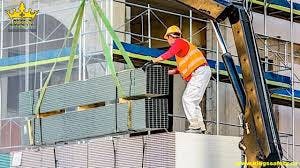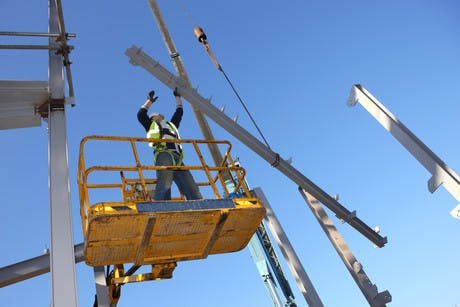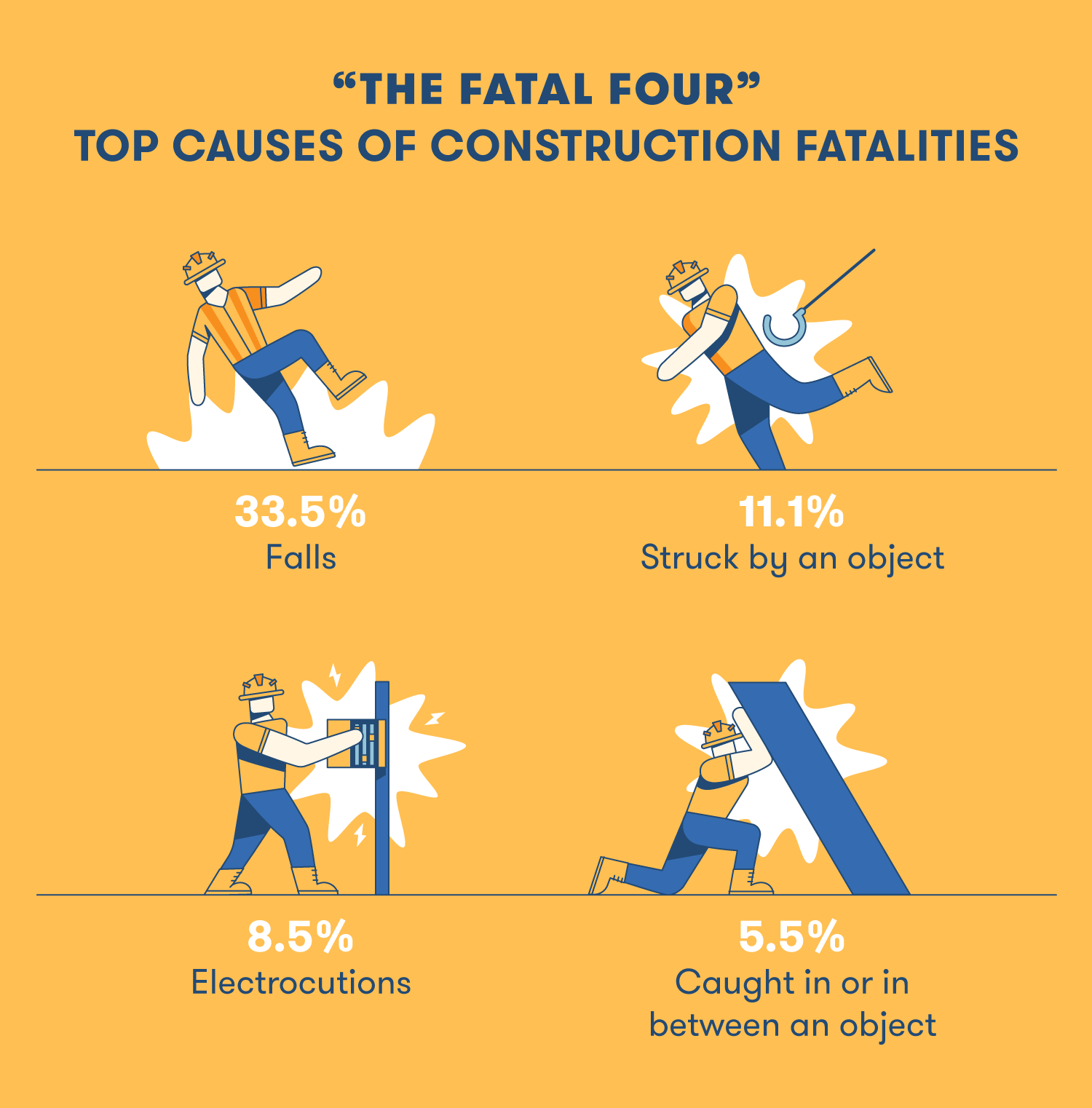Injuries Due to Falling Material on Construction Sites

In multi level construction projects materials must often be hoisted into place for the purposes of performing work, and secured in place for the purposes of the undertaking. There is a significant risk of injury to construction workers injured as a result of material falling from above.
New York State has a very protective provision of law on the books intended to provide near absolute liability for a worker injured by material being hoisted that falls upon them, or material being secured above that falls upon them, namely Section 240(1) of the New York State Labor Law. In fact the injuries do not necessarily need to be caused directly by the falling object upon them, but rather as a consequence of the falling object.
An injured construction worker always has a valid workers’ compensation claim against their employer’s insurance company. However, under certain types of construction related accidents, in addition to the workers’ compensation claim, injured workers may also have valid third-party action.
NEW YORK LABOR LAW PROVIDES NEW ABSOLUTE PROTECTION TO CONSTRUCTION WORKERS INJURED BY FALLING MATERIAL

Section 240(1) provides near absolute legal protection and liability as a matter of law to a worker injured as a result of material being hoisted or secured from above. The liability is imposed upon the general contractor and owner of qualified properties regardless of their respective active fault. This provision of law also prevents any claims of comparative fault on the part of the injured worker in so far as a violation of the statute has been proven.
Often in this category of case the plaintiff is able to win their case as a matter of law on a paper application known as a Summary Judgement Motion.
Multi-level construction sites are dangerous places and New York law recognizes the significant dangers imposed in this type of construction and as a result has placed the ultimate responsibility upon the general contractor and owners of qualified properties to ensure the compliance with the protections required under Section 240(1) of the New York State Labor Law.
When injured in a construction related accident, many construction workers and tradesmen do not understand the value of the third party action, which largely is of far greater value than the given workers’ compensation benefits, which the worker is entitled to regardless of whether there is an actionable third party case.
It is therefore important to consult with a law firm fully familiar with New York State Labor Laws in relations to construction relatives accidents when insured in New York State on a construction site.
If you or someone you care for has been injured by construction material falling from above on a construction site in the State of New York, please contact our firm. We take great pride in being of service to those who construct our City and State of New York.
STATUTORY PROTECTION – 240(1) New York State Labor Law:
All contractors and owners and their agents, except owners of one and two-family dwellings who contract for but do not direct or control the work, in the erection, demolition, repairing, altering, painting, cleaning or pointing of a building or structure shall furnish or erect, or cause to be furnished or erected for the performance of such labor, scaffolding, hoists, stays, ladders, slings, hangers, blocks, pulleys, braces, irons, ropes, and other devices which shall be so constructed, placed and operated as to give proper protection to a person so employed.

CASE LAW DEVELOPMENTS IN INJURIES ARISING FROM FALLING MATERIAL ON CONSTRUCTION SITES:
Wilinski v 334 East 92nd Housing Development Fund Corp., (Court of Appeals)
The Court of Appeals held that in order to recover under section 240(1) for falling material, the material must be at a height greater than the person injured. In this case 10 foot high plumbing pipes in demolition activity extending from the same level as the plaintiff was standing, that toppled over upon the plaintiff does not constitute an actionable difference in height. In short, something tipping even though taller does not constitute the required elevated difference that a 240(1) violation requires.
Runner v. New York Stock Exchange, Inc.
Plaintiff and co-worker were lowering an 800 pound reel of wire down a flight of stairs using rope wrapped around a bar (used as a pulley), with plaintiff on the bottom acting as a counter weight – the reel descended too quickly and plaintiff was pulled upward sustaining injury. Court held that a 240(1) violation occurred, “The single decisive question is whether plaintiff’s injuries were the direct consequence of a failure to provide adequate protection against a list arising from a physically significant elevation differential.”
Harris v. City of New York (1st Dept. 2011)
The force of the unchecked or insufficiently checked descent of a 1 ton slab of concrete, was a danger that was failed to be guarded against as plaintiff’s injuries arose directly from the effect of gravity.
Arnaud v. 140 Edgecomb LLC (1st Dept. 2011)
Liability determined in favor of the plaintiff where the worker was struck and injured by a wooden plank being lowered as the wood was an object that required securing for the purposes of the undertaking.
Pritchard v. Tully Construction Co., Inc. (2nd Dept. 2011)
Plaintiff injured by a motor weighing 300-350 pounds fell while others were trying to lift it and position it on the end of a pipe. The court found that the defendants were required to provide appropriate safety devices to hoist and secure the heavy object.
Melo v. Consol. Edison Co. (Court of Appeals)
The Court of Appeals (highest Court) found a requirement that there be an “appreciable” height difference between the work site and the falling object. The court held that the statute only applies “either because of a difference between the elevation level of the required work and a lower level or a difference between the elevation level where the worker is positioned and the higher level of the materials being hoisted or secured.”
Davis v. Wyeth Pharms., Inc. (3rd Dept. 2011)
Plaintiff injured by an object being moved horizontally and tipping over is not the result of an elevation risk differential required to establish a violation of 240(1) as the object was not being hoisted or being moved vertically from one elevation to another.
Boyle v. 42nd Street Development Corp.
The court held that liability under a falling object theory is not restricted to situations where the object is actually being hoisted or secured, but where the object requires “securing for the purposes of the undertaking.”
Outar v. City of New York, 5 N.Y.3d 731 (2005) (Court of Appeals)
A falling object even though within reach of the worker, still constitutes a violation of Section 240 (here a dolly) as long as it is supposed to be secured for the undertaking.
Fabrizi v. 1095 Avenue of the Americas, LLC, et al., 22 N.Y.3d 658 (2014) (Court of Appeals)
Electrician’s case was dismissed where he sustained injury when a 60 to 80 pound conduit pipe fell onto his hand. Plaintiff had cut the conduit above which was dangling by the compression coupling near the ceiling. The plaintiff was at the moment of accident was drilling on the floor when the conduit fell, striking the plaintiff on his hand. The highest court reaffirmed the proposition that the falling object must require securing for the purposes of the undertaking, and the fact that the object fell is not enough, the plaintiff must show that the object fell due to the absence or inadequacy of a safety device of the kind enumerated in the statute. The court held that the coupling device which was claimed to be inadequate that plaintiff himself dismantled was not meant to function as a safety device as those devices enumerated in the section 240(1).
Narducci v. Manhasset Bay Associates, et al., 96 N.Y.2d 259 (2001) (Court of Appeals)
Plaintiff was working on a ladder removing a window frame that was struck in the arm by a falling piece of glass from a window above. The plaintiff did not fall from the ladder, but his arm was injured by the glass. The glass that fell was not material being hoisted or a load that required securing for the purposes of the undertaking, as no-one was working on the window from where the glass fell and the glass that fell was part of the pre-existing building structure as it was in place before the work began. In short, it was not a situation where hoisting or a securing device of the kind set forth within the statute would have been necessary or expected.
O’brien v. 4300 Crescent LLC, et al., 2020 NY Slip Op 00914 (First Department)
Plaintiff was injured while unloading windows from a tractor trailer when a vertical stack of 8 or 9 windows tipped over onto him. A co-worker was holding the stack while he was removing one of the windows. The co-worker could no longer support the stack due to the weight as each window weighed 175 pounds. The lower court judge dismissed the 240(1) cause of action. The appellate division reversed, concluding that the windows were subject to the force of gravity and the elevation differential was not de minimis, as the combined weight could cause a significant amount of force in the short descent. The court found that a triable issue of fact was present as to whether the stack of windows required securing.
Cruz v. Metropolitan Transportation Authority, 2020 NY Slip Op 30194(U) (Supreme Court, New York County)
A 2 pound metal washer falling while resting on top of a bracket when a co-worker fumbled it was not the type of material contemplated that needed to be secured for the undertaking, due to weight and size.
Suwareh v. State, 24 A.D.3d 380 (2005) (First Department)
Worker on a roof sustained injuries to his foot after hauling a bucket of hot tar with a rope, when the bucket of hot tar got stuck on the ledge, and when trying to free it he lost his balance and lost control of the bucket, which spilled and burned his feet. Even though the worker was not injured from falling material, his injuries arose while working at an elevated height and with material being hoisted and was not provided with the proper protection as contemplated by Section 240. The injured worker therefore was entitled to summary judgment as to liability.
Blake v. Brookfield Properties One WFC Co., et al., 2020 NY Slip Op 00831 (First Department)
The worker was installing office furniture in a newly renovated leased space when an upper wall cabinet broke free from the wall after being installed. This type of falling object did not invoke the protections of Section 240 of the Labor Law. Even with the assumption that the work involved the altering of a building and therefore within the scope of protected work, the cabinet itself was not considered an object that required securing for the undertaking at the time it fell, and anti-dislodgement screws do not constitute a safety device within the meaning of Section 240.
Gutierrez v. 610 Lexington Property, LLC, et al., 2020 NY Slip Op 00361 (First Department)
Worker who was receiving a heavy wooden form for concrete from another worker standing above on a scaffold and the worker below was unable to control the form’s descent and fell backwards. The fact that there was a nail embedded in the form and scratched the plaintiff immediately prior to losing control did not take the case out of the protection of Section 240(1) of the Labor Law, and therefore entitled to Summary Judgment on liability.
Garcia v. SMJ 210 W.18 LLC, 2019 NY Slip Op 08791 (First Department)
Injuries occurred to a worker while on a temporary exterior platform when struck by a falling piece of DensGlass that matched a missing piece one floor above. Other workers were performing patch work to the DensGlass on floors above and the exterior facade was not complete. Plaintiff entitled to judgment as a matter of law against defendants based upon violation of Section 240(1). Furthermore, the Section 241(6) claim predicated on a violation of 12 NYCRR 23-1.7[a][1], requires suitable overhead protection must be provided where the accident occurred and was normally exposed to falling material or objects.
Goncalves v. New 56th and Park (NY) Owner, LLC, et al., 2019 NY Slip Op 08265 (First Department)
Appellate Division reverses lower court’s denial of plaintiff’s motion for liability and grants plaintiff’s motion as a matter of law pursuant to Section 240. Plaintiff had some conflicting representations of whether he was struck by the hoist system chain or the entire hoist system from above. Court finds that either way the plaintiff is entitled to judgment in his favor.
Ortega v. Trinity Hudson Holding LLC, et al., 2019 NY Slip Op 07743 (First Department)
Plaintiff sustained serious fractures to his hand that was pinned under a “delta scaffold” to the bracket on the wall. Even though the scaffold and counterweights only fell a short distance, the elevation differential was not de minimis as the combined weight was over 2,400 pounds. Plaintiff prevailed as a matter of law pursuant to Section 240(1) of the New York State Labor Law.
Encarnacion v. 3361 Third Avenue Housing Development Fund Corporation, et al., 176 A.D.3d 627 (2019)
Plaintiff injured from large brace frames that were part of form work that had been used to form a concrete wall. Supervisor lifted the formwork out of an excavation pit and moved it to ground level. The form work remained connected to the escalator bucket via chain and the brace frames that were in place where attached to the form work. The plaintiff disconnected the brace frames from the panel so the panel could be laid flat. The brace frames were 12 feet tall and weighed approximately 1,500 pounds. Upon removing the connection pins the brace frame fell and struck him. What is important about this case, is even though the brace frames were at the same level at the time of the accident, the work plaintiff was doing posed a substantial gravity related risk, generating significant force and thereby invoked the protection of New York State Labor Law Section 240(1).
Ali v. Sloan-Kettering Institute for Cancer Research, et al., 176 A.D.3d 561 (2019) (First Department)
Violation of Section 240(1) found where the plaintiff was injured when a 300 pound air-conditioning system coil was being unloaded from the liftgate of a truck while attached to a dolly, when the wheel of the dolly got stuck on the gap in the lift gate. As a result the coil tipped over and fell on the plaintiff. The court found that in view of the amount of force generated, despite the short distance, the injury arose as a result of the failure to provide protections required by Section 240(1) of the New York State Labor Law.
DiGidio v. City of New York, 176 A.D.3d 452 (2019) (First Department)
Injuries sustained while trying to avoid collapsing hoisting equipment my quality. In this case the plaintiff was injured in the effort of attempting to avoid a collapsing crane. Even though not directly injured by the crane itself, injuries arising out of the collapse demonstrate a prima facie showing of violation of Section 240(1).
Lombardi v. City of New York, 175 A.D.3d 1521 (2019) (Second Department)
Foreman of New York Paving, a company hired by Brooklyn Union Gas Company, was injured when he was struck by a metal plate as it was being removed from the roadway. Without a detailed explanation of the height differential, the court held as a matter of law that the injury did not arise as a result of the type of elevated- related hazard contemplated by Section 240(1).
INJURIES AS A RESULT OF FALLING MATERIAL ON A CONSTRUCTION SITE CAN HAVE DEVASTATING CONSEQUENCES:
New York Law rightfully recognizes the significant danger falling material on a construction site exposes workers to and as a result New York has very protective provisions in place for this category of construction site accident. Falling material that was improperly secured or hoisted can cause devastating injuries and even death to workers working below. If you or someone you care for has been injured on a New York construction site as a result of falling material, please contact our office without a moment of hesitation. We will carefully analyze the facts of your case and provide you with an honest opinion as to the merits of your claim, and if there is a case we will do everything in our power to advance your legal interests and secure you the best recovery possible.
What is My Injuries Due to Falling Material on Construction Sites Accident Case Worth?
Contact The Law Office of Joel J. Turney, LLC today and find out what your case is worth. Call (212) 840-7000 or submit this form for a FREE case evaluation.

